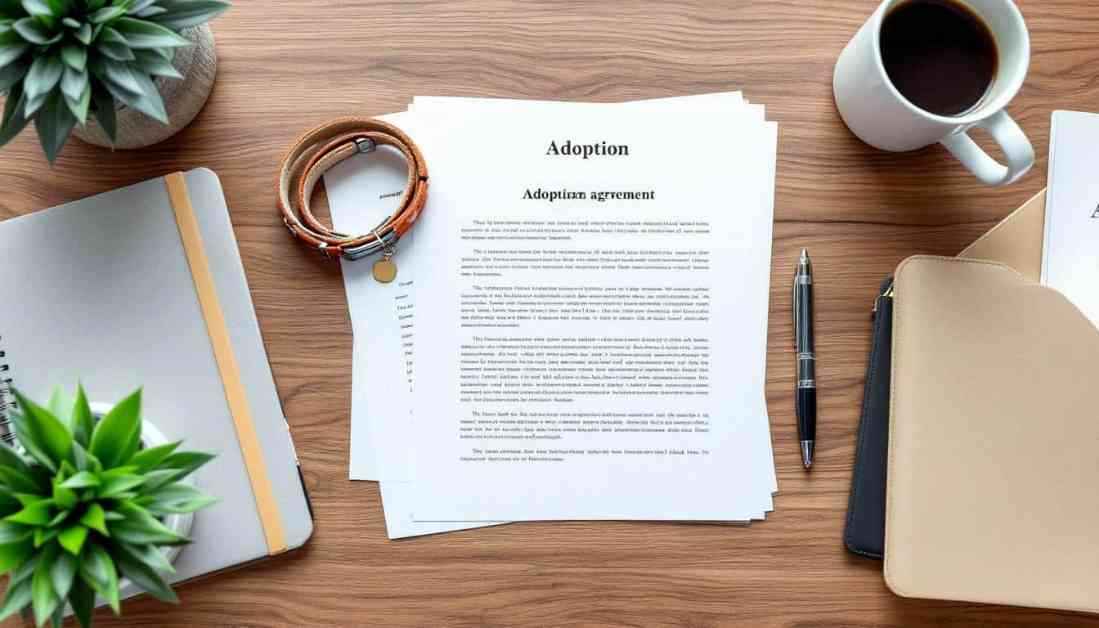Adopting a dog is a heartwarming experience, but it comes with important responsibilities. At DogingtonPost, we believe understanding your dog adoption agreement is crucial for a successful adoption process. This legal document outlines the terms and conditions between you and the shelter or rescue organization. We’ll guide you through the key components of a typical dog adoption agreement, helping you navigate this important step in welcoming a new furry family member.
Your Details and Responsibilities
When you decide to adopt a dog, you embark on a journey filled with love, companionship, and responsibility. Dog adoption agreements serve as a roadmap for responsible pet ownership, protecting both the dog and the adopter. As you begin the adoption process, you’ll need to provide your personal information, such as your name, address, and contact details. Beyond that, the agreement outlines your responsibilities for the dog’s care, encompassing food, shelter, and medical needs. Some agreements even specify the type of care required, such as regular vet check-ups or specific diets tailored to the dog’s health needs.
All About Your New Furry Friend
Every dog has a unique story, and within the pages of your adoption agreement, you’ll find essential details about your new furry family member. This section typically includes the dog’s name, breed (or best guess for mixed breeds), age, and any known medical history. Paying attention to these specifics is crucial, as the American Society for the Prevention of Cruelty to Animals (ASPCA) reports that millions of companion animals enter U.S. shelters annually. Each of these animals has a distinct history that shapes their care needs and behavior.
The Cost of Adoption
As you delve into the adoption process, you’ll encounter varying adoption fees set by different organizations. These fees often cover initial veterinary care, vaccinations, and sometimes microchipping for identification purposes. While adoption fees are just a small part of the significant amount Americans spend on their pets annually, they remain an essential consideration. Some shelters offer reduced fees for senior dogs or during special events to encourage adoptions, making the process more accessible for potential pet owners.
Spay/Neuter Policies
One of the critical components of dog adoption agreements is the inclusion of a spay/neuter clause. This clause is vital for responsible pet ownership and population control, ensuring that you take the necessary steps to prevent unplanned litters. Many shelters require proof that the procedure has been completed within a specific timeframe, typically 30 to 60 days post-adoption. If the dog is too young at the time of adoption, the agreement will specify when the procedure should be done, usually between 6-9 months of age. By adhering to this clause, you play a crucial role in promoting the well-being of your new furry companion and contributing to a more sustainable pet population.
Understanding the Fine Print
Signing a dog adoption agreement involves more than just formalities—it sets the stage for a lasting and fulfilling relationship between you and your new four-legged friend. These agreements are designed to ensure the well-being of the dog and establish legal responsibilities for both parties involved. As you navigate through the agreement, you’ll come across various aspects of pet care and legal obligations that set the foundation for a successful adoption.
What’s in the Fine Print?
Beyond the basic care requirements outlined in adoption agreements, there are additional clauses that aim to protect the dog’s welfare and ensure a harmonious adoption process. Let’s explore some common clauses you might encounter in your adoption agreement.
Return Policies
Most shelters include a return policy in their agreements, allowing adopters to bring the dog back within a specified timeframe if the adoption doesn’t work out. These policies typically offer a grace period, often around 30 days, during which you can return the dog without penalty. By having clear return policies in place, shelters aim to facilitate successful adoptions and prioritize the well-being of the animals in their care.
Home Checks and Follow-ups
Your adoption agreement may include a clause about home visits, where shelters reserve the right to check on the dog’s welfare post-adoption. These visits, usually conducted within the first few months after adoption, serve the dual purpose of ensuring the dog’s adjustment to its new home and providing support to adopters as needed. By allowing for these follow-ups, shelters maintain a connection with adopters and offer resources for a smooth transition for both the dog and its new family.
Training Commitments
In some cases, adoption agreements may require specific training or socialization for the adopted dog. This is particularly common for dogs with known behavioral challenges or those in need of additional support. By mandating training commitments, shelters aim to set up both the dog and the adopter for success, fostering a positive and enriching relationship between the two.
Restrictions on Rehoming
Adoption agreements often include clauses that restrict rehoming or transferring ownership of the dog to other parties. These restrictions are put in place to prevent the dog from ending up in unsuitable homes or returning to the shelter system. If circumstances change and you can no longer care for the dog, most agreements require you to return the animal to the original shelter, ensuring the dog’s well-being and safety.
The Reasoning Behind the Rules
While these clauses may seem stringent, they are designed with the best interests of the dog in mind. By adhering to the terms of the adoption agreement, you contribute to the successful placement of dogs in loving homes and help reduce the number of animals entering shelters annually. These rules aim to create a supportive and responsible environment for both the dogs and their adopters, fostering a lasting bond built on care and commitment.
Understanding these clauses is essential for embracing the responsibilities of dog ownership and ensuring a harmonious relationship with your new pet. However, the legal considerations surrounding adoption agreements extend beyond these common conditions. Let’s delve deeper into the legal aspects that shape these agreements and safeguard the welfare of dogs and adopters alike.
Legal Aspects of Dog Adoption Agreements
As you embark on the journey of dog ownership, it’s crucial to understand the legal implications of adoption agreements and the responsibilities they entail. These agreements are legally binding contracts that protect both the dog and the adopter, ensuring a smooth transition and a fulfilling relationship for all parties involved.
Liability Waivers
Most adoption agreements include liability waivers, requiring adopters to waive all liability against the shelter and indemnify the shelter in case of legal action related to the adopted animal. By signing the agreement, you assume full responsibility for the dog’s actions, potentially facing liability in the event of incidents such as biting or property damage. It’s essential to review your homeowner’s or renter’s insurance policy to confirm adequate coverage for pet-related incidents, safeguarding both you and your new pet.
State Laws and Local Regulations
Dog adoption laws vary across states and cities, with specific regulations governing the adoption process and pet ownership. Familiarizing yourself with local pet laws is crucial before signing an adoption agreement, as violations could result in fines or even the surrender of your pet. Your local animal control office or city clerk can provide valuable information on these laws, empowering you to make informed decisions and navigate the legal landscape of dog ownership effectively.
Enforcement of Agreement Terms
Shelters take adoption agreements seriously, and breaching the contract could have consequences, including the potential reclamation of the dog by the shelter. Actions that may lead to contract violations include failing to provide proper care, attempting to rehome the dog without permission, or violating other terms outlined in the agreement. Some agreements even stipulate that the adopter is responsible for legal fees if court intervention is required to enforce the terms of the agreement, underscoring the gravity of these legal documents.
Microchipping and Registration
Many adoption agreements mandate microchipping as part of the adoption process, ensuring a reliable method of identification for your new pet. This involves implanting a small chip under the dog’s skin, containing a unique identification number that can be scanned to retrieve your contact information if the dog gets lost. Additionally, some agreements require you to register the microchip in your name within a specific timeframe, typically around 30 days post-adoption. Compliance with these requirements is essential to fulfill the terms of the agreement and safeguard your pet’s well-being.
Understanding the Fine Print
As you navigate the legal intricacies of dog adoption agreements, remember that these documents are designed to protect both you and your new furry companion. Reading the agreement carefully, seeking clarification on any unclear terms, and understanding your obligations are critical steps in establishing a strong foundation for a successful adoption. By adhering to the terms outlined in the agreement, you demonstrate your commitment to responsible pet ownership and set the stage for a fulfilling relationship with your new best friend.
Final Thoughts
Dog adoption agreements are more than just legal documents—they represent a promise of care, responsibility, and love for your new pet. By embracing the terms and conditions outlined in these agreements, you embark on a journey of companionship and shared experiences with your furry family member. At DogingtonPost, we stand by you every step of the way, offering support, guidance, and resources to ensure a seamless transition into your role as a pet owner.
It’s important to remember that dog adoption agreements play a vital role in safeguarding animal welfare, promoting responsible pet ownership, and reducing the number of animals in shelters. By upholding the terms of the agreement and fulfilling your responsibilities as an adopter, you contribute to the broader goal of creating safe and loving homes for dogs in need. Your commitment to your new pet and the obligations outlined in the adoption agreement marks the beginning of a beautiful journey filled with love, joy, and cherished memories.





















